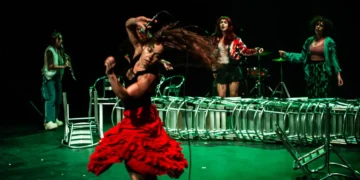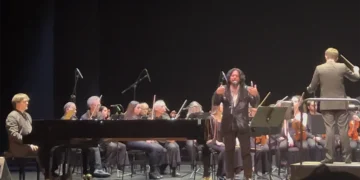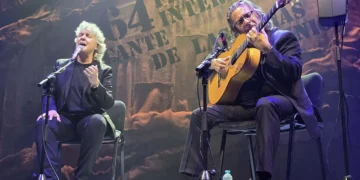|
‘ALQUITARA. LA ESENCIA DE LOS SENTIDOS’ |
||
|
SPECIAL BIENAL DE FLAMENCO DE SEVILLA 2008 Text: Estela Zatania Guitar and music director: José María Gallardo del Rey. Flute: Ezequiel Cortabarría. Clarinet: Vicente Sabater. Viola: Eva Martín. Cello: Michal Dmochowski. Double bass: Germán Muñoz. Percussion: Roberto Vozmediano. Special guesta artists: Paco del Pozo (voice), Pilar Ortega (dance), Félix Grande (recitation). A septet with classical guitarist, wind instruments, other strings and percussion. Exquisite composition, interpretation and execution of a carefully constructed program of well-known and original pieces. A singer and a dancer. A poet. These are the ingredients of the dish José María Gallardo served up at the Lope de Vega theater within the framework of Seville’s Bienal de Flamenco. Many years ago big companies such as those of Mario Maya and Manuela Vargas, formalized the divorce between classical Spanish dance and flamenco, offering, since the end of the nineteen-sixties, theater works based entirely on flamenco forms, a formula that was repeated thereafter by countless groups, large and small. Now, decades later, Seville classical guitarist José María Gallardo del Rey, has tried to bring the two worlds together once again. The concept is not without merit, but it’s not enough to declare “This show is a many-layered and fervent tribute to Flamenco”, the breathless phrase that appears on the group’s glossy promotional brochure, as well as the program. The repertoire included some of the most beloved and most often danced compositions of the historic ballets, from Argentiinita, Pilar López, Antonio or José Greco, up to the very flamenco Carmen Amaya. If Falla’s “Three-cornered Hat”, “Amor Brujo” and “Vida Breve” mix classical sounds with contemporary Andalusian ones, “Sevilla” and “Córdoba” by Albéniz are attractive, well-known melodies, and we all carry around inside of us the songs arranged and recorded by Lorca such as “Anda Jaleo”, “La Tarara” and “Los Peregrinitos”. All this, and also original works by Gallardo del Rey himself, in addition to a tribute to Argentine musician Astor Piazzolla. But not even flamenco singer Paco del Pozo, nor the wonderful dancer Pilar Ortega were allowed to dip into flamenco. Carmen Amaya had her Sabicas, but these two young artists had to find inspiration in unaccustomed music and rhythms, and you know how fussy the duende is. Del Pozo did what he could, bringing classical melodies to his own territory with a flamenco voice and delivery. The dancer came off a bit worse: she danced well, but was unable to find a language that would adapt to the natural delicacy of the music. The casual listener may not distinguish between flamenco and classical guitar, but for followers of either specialty, they are two absolutely independent universes. The classical guitarist’s touch is very different from the flamenco’s, there are different techniques, especially in the strumming and picado, and of course, flamenco forms or palos are not present in classical music. An encore of sevillanas in which Pilar danced with the percussionist was the almost flamenco ending, but the beautiful music of this beautiful recital scored yet another point for the non-flamenco team, and the genre is today a little closer to the terminal “dignification” that is so intensely being cultivated.
|
||
Descubre más desde Revista DeFlamenco.com
Suscríbete y recibe las últimas entradas en tu correo electrónico.


 XV BIENAL DE FLAMENCO DE SEVILLA
XV BIENAL DE FLAMENCO DE SEVILLA























